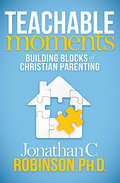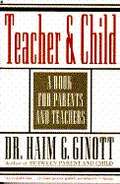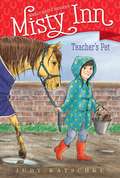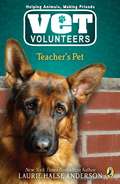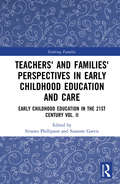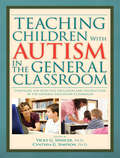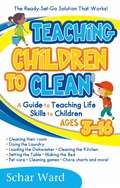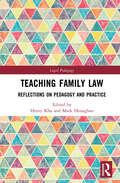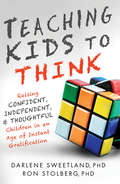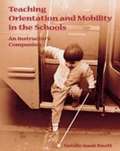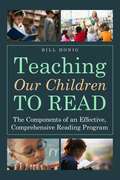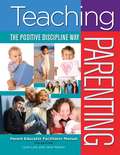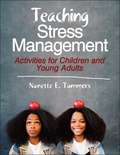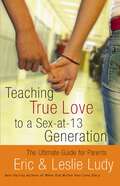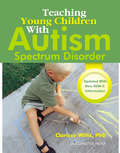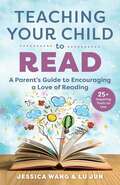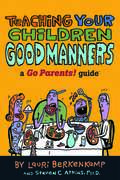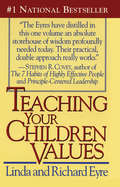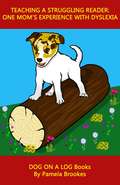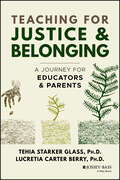- Table View
- List View
Teachable Moments: Building Blocks of Christian Parenting
by Jonathan RobinsonCommunication strategies for building a better relationship with your children, from a psychologist who has worked with families for over three decades. Are you frustrated when your child is not responsive to your efforts to be a good parent? Are you shaking your head in confusion or barking orders as a last resort in getting through to him/her? Do you wish for more quality time with your child? Parenting is the toughest job—for which most parents have no training. We tend to emulate our own parents, for good or for bad. In the Bible, Proverbs 22:6, we are told to &“train your children in the ways of the Lord, so that when they are old, they will not depart from Him.&” Teachable Moments: Building Blocks of Christian Parenting is a source book for parents and helping professionals who want both the spiritual context and the step-by-step practical parenting tools with which to be effective, engaged, Christian parents. Are you ready to move from surviving to thriving in your relationship with your children? You will learn: –Nine parenting perspectives to guide your understanding of your child –How communication defines relationship and the four distinct types of communication to use when your child is not having problems –Eleven specific communication tools and behavior management strategies, and more The author, a licensed clinical psychologist with decades of experience in practice, also includes &“Learn the Concept&” exercises embedded within the chapters—so you can practice these tools and strategies and start enjoying a better relationship with your children today.
Teacher and Child: A Book for Parents and Teachers
by Haim G. GinottGives both the teachers and parents an insight to psychological problem children encounter in everyday situation.
Teacher's Pet
by Judy Katschke Serena GeddesA back-to-school assignment has Willa scrambling in this seventh book of a chapter book series inspired by Marguerite Henry’s Misty of Chincoteague.Willa just started school again and everyone in her class has come up with clever ideas for their back-to-school projects. Even her best friends Lena and Sarah are preparing something different: a Double-Dutch demonstration. At first Willa thinks her father’s fabulous raspberry torte will be perfect, but at the last minute, the raspberries don’t cooperate! Just in the nick of time she realizes the best idea is in her own barnyard: Starbuck! She’ll show her class how to groom him, something she’s an expert at!
Teacher's Pet: Maggie (Vet Volunteers #7)
by Laurie Halse AndersonMaggie's still getting used to middle school. One of her teachers is, too - Mr. Carlson, her new science teacher, is blind, and is working with a guide dog for the first time. Scout is a love of a German shepherd and really wants to do his job, but Maggie can tell that Mr. Carlson's still having a hard time. Maybe she can help. . . .
Teachers' and Families' Perspectives in Early Childhood Education and Care: Early Childhood Education in the 21st Century Vol. II (Evolving Families)
by Susanne Garvis Sivanes PhillipsonThe second volume in this Early Childhood Education in the 21st Century: International Teaching, Family and Policy Perspectives miniseries focuses on teacher and family perspectives of early childhood education and care from 19 different countries around the world. The aim of this volume is to articulate the key components of teacher education and family practices that impact young children’s education and care. Each country featured in this volume presents its own unique perspective in relation to the cultural and societal constraints around teacher training and/or family practices and the thinking around those practices that are important for early childhood development. Offering a unique insight into how teachers and families work together in different countries, the book is essential reading for early childhood educators, researchers, early childhood organisations, policy makers and those interested to know more about early childhood within an international perspective.
Teaching Children With Autism in the General Classroom
by Vicky G. Spencer Cynthia G. SimpsonSuccessful strategies for educating students with autism in the regular classroom. Recent special education legislation has led to a rise in inclusion classrooms, where students with special needs, including autism spectrum disorders, are taught alongside their nondisabled peers. Teaching Children with Autism in the General Classroom provides an introduction to inclusionary practices that serve children with autism, giving teachers the practical advice they need to ensure each student receives the quality education he or she deserves. Promoting field-tested strategies and techniques, this book offers teachers sound advice for creating a classroom environment conducive to learning success for children with autism spectrum disorders. The easy-to-use tips and tools included also aide teachers in organizing and managing their classrooms to maximize instruction for students of all ability levels. Detailed resource guides and concise overviews of special education legislation also are provided to give general education teachers a solid background of knowledge about autism and the needs of students with the disorder.
Teaching Children to Clean: The Ready-Set-Go Solution That Works!
by Schar WardThis book contains step-by-step instructions for teaching children and teenagers to clean an entire house. Plus many other life skills such as doing laundry, loading a dishwasher properly, and making a bed. Cleaning is not an option, it's a necessity! If your child doesn't learn, it'll plague them the rest of their lives. According to the latest research, teaching your child to clean may be the most important thing you ever do for them! You want your child to learn basic life skills, but finding the time for accomplishing this seems to get more difficult each day. What's the answer? A new approach, that practically does it for you! You'll find it in these pages and even more: * The research on children & cleaning * Proven tactics to get the job done * Chore charts for every age * Room evaluations for easier cleaning * What tools they need * Safe green cleaning solutions, you can make yourself * Checklists for detailed cleaning in very room * How to clean appliances * How to do laundry, set the table and everyday chores * How to take care of pets * Fun cleaning games. Knowing how to take care of yourself in your everyday environment is a skill no one should be without!
Teaching Family Law: Reflections on Pedagogy and Practice (Legal Pedagogy)
by Henry Kha and Mark HenaghanThis book provides a comprehensive analysis of the teaching of an eclectic range of family law topics and the unique opportunities and challenges of teaching family law in different jurisdictions from a varied international perspective. Written by leading legal scholars, the book addresses a gap in the scholarship to comprehensively and systematically analyse the teaching of family law. The first part of the book explores ways of teaching the varied range of topics under the heading of family law and captures the diverse approaches to the discipline. Chapters illustrate how the subject can be best taught in an interdisciplinary way that considers feminist perspectives and the philosophy of teaching, while encompassing legal positivism, empirical research and critical legal theory. The second part of the book examines teaching in different jurisdictions and illustrates policy and practice in Australia, New Zealand, the United States, Canada, the United Kingdom, Hong Kong and South Africa. Showcasing examples of best practice of teaching family law, the book will be an essential reading for legal scholars, as well as researchers and postgraduate students in the fields of family law and legal education.
Teaching Infants, Todders & Twos with Special Needs
by Clarissa WillisPlacing children with special needs in environments that include typically developing peers has become commonplace as continuing research confirms that all children benefit and learn from each other as well as from their teachers. Teaching Infants, Toddlers, and Twos with Special Needs is written for all teachers and directors who work with infants, toddlers, and twos, including special educators and educators working with typically developing children. This book specifically addresses the needs of children with developmental delays, as well as children at risk for developing special needs. Each chapter in Teaching Infants, Toddlers, and Twos with Special Needs includes information about how young children learn. The strategies and adaptations in each chapter are easy to use and apply to all children. Examples are presented for managing the physical environment and for teaching skills that will enhance the overall development of infants, toddlers, and twos with special needs.
Teaching Kids to Be Kind: A Guide to Raising Compassionate and Caring Children
by Rachel TomlinsonA simple and sweet parenting book with 365 tips—a new one to try every day! As a parent, you want the best for your child, and one of your greatest hopes is that your child will grow up to be a good person. So, what makes a good person? Generally, we think about good people as being kind: those who are compassionate, empathetic, generous. However, it seems that, in our fast-paced, individual-driven society, kindness is fading and the pressure on parents to raise socially conscious, empathetic, and caring children can seem overwhelming at times.In Teaching Kids to Be Kind, Rachel Tomlinson draws from her professional experiences to provide 365 inspiring strategies to help children and families practice kindness every day of the year. Daily tips include:Taking your child shopping around the holidays to select a new toy to donate to another little boy or girl their age.Leaving little notes in their lunch box or school bag for them to find. This models unconditional love and consideration for others.Baking a cake together to teach patience and teamwork and build on their ability to delay gratification. An essential tool for parents, Teaching Kids to Be Kind will help children develop empathy, regulate their emotions, and improve their general well-being as well as support families in strengthening their overall relationships.
Teaching Kids to Think
by Darlene Sweetland Ron StolbergWhy Do Kids These Days Expect Everything to be Given to Them?Today's kids don't know how to read a map. They can Google the answer to any question at lightning speed. If a teen forgets his homework, a quick call to mom or dad has it hand-delivered in minutes. Fueled by the rapid pace of technology, the Instant Gratification Generation not only expects immediate solutions to problems--they're more dependent than ever on adults. Today's kids are being denied opportunities to make mistakes, and more importantly, to learn from them. They are being taught not to think.In Teaching Kids to Think, Dr. Darlene Sweetland and Dr. Ron Stolberg offer insight into the social, emotional, and neurological challenges unique to this generation. They identify the five parent traps that cause adults to unknowingly increase their children's need for instant gratification, and offer practical tips and easy-to-implement solutions to address topics relevant to children of all ages.A must-read for parents and educators, Teaching Kids to Think will help you understand where this sense of entitlement comes from--and how to turn it around in order to raise children who are confident, independent, and thoughtful.
Teaching Orientation and Mobility in the Schools: An Instructor's Companion
by Natalie Isaak KnottTeaching Orientation and Mobility in the Schools: An Instructor's Companion offers orientation and mobility (O&M) instructors and professionals working with students with visual impairments insights and advice. The book offers creative instructional methods and practical strategies as well as useful forms and checklist.
Teaching Our Children to Read: The Components of an Effective, Comprehensive Reading Program
by Bill HonigStudies of effective teaching practices have continued to validate the need for explicit and systematic instruction in basic reading skills, and Bill Honig uses this research to shed new light on an old problem-how to help all students become fluent readers. Teaching Our Children to Read grows out of the experiences of scores of dedicated teachers and their success in the classroom. This book explores current research from the leading experts in the field, and presents new instructional strategies that bring all students to higher levels of literacy.Highlights from Teaching Our Children to Read include: Phonics instruction and fluency Connected practice with decodable text Multisyllabic word instruction Spelling, vocabulary, and concept development Strategic reading, book discussions, and text organization Literacy benchmarks, assessment, and interventionThis is an essential resource for educators, administrators, policymakers, and parents concerned about how to successfully teach our children to read. Teaching Our Children to Read points the way to implementing the best research-based practices in adopting reading materials, training teachers, and providing the necessary school leadership.
Teaching Parenting: The Positive Discipline Way
by Jane Nelsen Lynn LottTeaching Parenting the Positive Discipline Way (developed by Lynn Lott and Jane Nelsen) is a research-based parent education program that provides a step-by-step approach to starting and leading experientially based parenting groups.
Teaching Stress Management: Activities for Children and Young Adults
by Nanette E. TummersStress is pervasive in the lives of today's children and youth. Without adequate coping skills, students might engage in risky behavior and make poor decisions that have negative consequences for themselves and others. Now, for the first time, there's a resource for K-12 teachers that's devoted to helping kids manage stress. "Teaching Stress Management: Activities for Children and Young Adults "helps current and preservice teachers understand the causes and effects of stress in students. This handy text - presents the most current evidence-based research with practical applications; - supplies teachers with 199 low- to no-cost activities that reinforce the curricular concepts; - equips students to deal proactively with stress; and - helps teachers apply various aspects of the positive psychology movement, including optimism, social support, resiliency, right-brain engagement, mindfulness-based stress reduction, responsive classroom techniques, and emotional and social intelligence. The text provides teachers with foundational material on the physiology and psychology of stress so they understand how stress affects health on a long-term basis. And through the book's numerous tips, teachers and administrators will be able to incorporate the principles of stress management in the classroom and integrate them in their wellness and health policies and programs. Teaching students the skills of stress management can have a positive impact on schools' social climate--reducing conflict, bullying, and violence. In addition, "Teaching Stress Management" will help teachers meet the National Health Education Standards with an overall focus on standard 7, in which students practice health-enhancing behaviors. Teachers will also learn how to advocate for stress management programs in their schools. Managing stress is a critical skill that every student needs to master. "Teaching Stress Management" will help them learn to cope with current pressures, reduce future stress, and strengthen the stress management skills that will serve them not only now but throughout their lives.
Teaching Students with Autism Spectrum Disorders: A Step-by-Step Guide for Educators
by Roger Pierangelo George A. GiulianiGives general educators the precise information needed to work with children on the autistic spectrum. The range of topics covered makes this book a great resource for professionals looking for an overview of autism spectrum disorders and how to work effectively with this population. I particularly like the chapter on collaborating with parents-a much needed, but often neglected area' - G. Richmond Mancil, Assistant Professor, University of Central Florida 'Most comprehensive. Teachers in today's classrooms are faced with the challenge of educating all children, and this book provides an easy-to-understand reference for a traditionally misunderstood disability' - Vicki McFarland, Special Education Director, Learning Matters Educational Group A user-friendly, comprehensive look at teaching students with Autism Spectrum Disorders. Written by experts in special education, this resource presents a complete overview of Autism Spectrum Disorders (ASD). The authors discuss ways to create an appropriate learning environment and essential strategies for implementing effective educational programs. The book also explains the use of: Assistive technology options for children with ASD Behavioural, skill-based, and physiologically-based intervention models Ways to evaluate interventions Effective assessments for student behaviour, skills, and deficits A comprehensive team approach that includes parents as part of a quality educational program Specific instructional approaches for students with ASD
Teaching True Love to a Sex-at-13 Generation: The Ultimate Guide for Parents
by Eric LudyNo parent wants to admit that their child-even their well-educated, well-grounded, Christian child-could be having consensual sex before graduating middle school. Promise rings, parental contracts and disease warnings provide but meager defense against a culture overrun with weapons of mass seduction. While many factors contributing to the misguided messages received by children stand outside the realm of parental control-music videos, film, fashion-others, like the meaning of true love, can, and should be fostered at home. Eric and Leslie Ludy, authors of the bestselling When God Writes Your Love Story, present the shocking, unvarnished realities of today's sexual climate but they balance the bitter pill with a large dose of hopeful, practical advice for parents.
Teaching Young Children with Autism Spectrum Disorder
by Clarissa WillisWhat do you do when a three-year-old with autism falls on the floor kicking and screaming? How do you communicate with a child who looks away and flaps his hands? Who can help if you suspect a child in your class has autism? Preschool can be overwhelming for a child with autism. Autism affects how a child communicates, behaves, and relates to others. Teachers need to know what they can do to help children with autism reach their full potential. Teaching Young Children With Autism Spectrum Disorder is a straightforward, easy-to-understand guide to working with children who have autism. It explains the major characteristics associated with autism and helps teachers understand the ways children with autism relate to the world. Each chapter offers specific strategies for teachers to use, including setting up a proactive preschool environment, helping children learn life skills, managing behavior, helping children with autism communicate, encouraging children with autism to play, helping them to get along with others, and working with families. Teaching Young Children With Autism Spectrum Disorder helps teachers connect with all children in meaningful ways, allowing children with autism to learn and grow. Updated with new DSM-5 information.
Teaching Your Child How to Pray
by Rick OsborneHow much do your children know? We teach our children academics. We give them instruction in the arts and physical fitness. We show them how to swim, skate, and ride a bike. But have we forgotten the most basic and necessary skill of all? Have we taught them to pray? Prayer is the foundation for communicating with God, growing as a person, and receiving help and wisdom for every other part of life. Teaching children to pray is one of the most important tasks parents have. Inside Teaching Your Child to Pray you will find:Answers to your children's questions about prayer Practical tips, helps, and activities for teaching the discipline of prayer What the Bible says about children and prayer Stories and examples of how prayer works Ways to reap the benefits of prayer for your children and see it affect their livesGive your children a real head start. Teach them to communicate with the Savior. It will make an eternal difference.
Teaching Your Child How to Pray
by Rick OsborneHow much do your children know? We teach our children academics. We give them instruction in the arts and physical fitness. We show them how to swim, skate, and ride a bike. But have we forgotten the most basic and necessary skill of all? Have we taught them to pray? Prayer is the foundation for communicating with God, growing as a person, and receiving help and wisdom for every other part of life. Teaching children to pray is one of the most important tasks parents have. Inside Teaching Your Child to Pray you will find:Answers to your children's questions about prayer Practical tips, helps, and activities for teaching the discipline of prayer What the Bible says about children and prayer Stories and examples of how prayer works Ways to reap the benefits of prayer for your children and see it affect their livesGive your children a real head start. Teach them to communicate with the Savior. It will make an eternal difference.
Teaching Your Child to Read: A Parent's Guide to Encouraging a Love of Reading
by Jessica Wang Lu JunIs your young child often disinterested in the books you bring home for them? Do you wish they would develop a love for reading that they could take into middle school and beyond? Some children love reading, requesting the same books over and over again and giggling with delight each time, while others simply despise sitting down for story time. What makes the difference in these two types of children? No child is born knowing how to read, so where does their interest come from? How do you encourage it? Like eating and drinking, reading is a daily necessity for every child. Parents should consciously guide and conform to their children&’s interest in reading with appropriate reading materials whenever possible. Books should take priority over watching television and playing video games. Professional and systematic training can help children start to love reading, maintain good reading habits, and improve their reading ability.Teaching Your Child to Read is a guide book for parents looking to get their children, ages 3 to 6, interested in reading. It explains how to help children cultivate reading ability step by step, as well as answers the questions of Why should I? and How do I? when it comes to specific exercises. Tools parents will learn to use in their efforts include:interval questioningobject comparingemotional contrastingplot mappingand more!
Teaching Your Children Good Manners (a Go Parents! Guide®)
by Lauri Berkenkamp Steven C. AtkinsFor parents everywhere who have had lovely family dinners ruined by misbehaving children, help is at hand. This guide provides a humorous, hands-on, parent-friendly approach to teaching children of all ages good manners in a wide variety of social situations, from accepting gifts graciously to which foods are OK to eat with fingers. Each chapter tackles a different situation, gives a brief outline of what manners are appropriate for it, and offers advice on how to teach and reinforce them to children of different ages. There is also a "What to Expect" chart broken down by age, and a Q & A section devoted to questions concerning children and manners.
Teaching Your Children Values
by Richard Eyre Linda EyreOne of the greatest gifts you can give your children is a strong sense of personal values. Helping your children develop values such as honesty, self-reliance, and dependability is as important a part of their education as teaching them to read or how to cross the street safely. The values you teach your children are their best protection from the influences of peer pressure and the temptations of consumer culture. With their own values clearly defined, your children can make their own decisions -- rather than imitate their friends or the latest fashions. In Teaching Your Children Values Linda and Richard Eyre present a practical, proven, month-by-month program of games, family ctivities, and value-building ecercises for kids of all ages.
Teaching a Struggling Reader: One Mom's Experience with Dyslexia (DOG ON A LOG Books #1)
by Pamela BrookesThere are a lot of children (and adults) who struggle with reading. Some are helped by their schools, some are not. <P><P>In this short booklet, Pamela Brookes shares some of the basic information she wishes she'd had when she was first trying to figure out how to help her child learn to read. <P><P>Teaching A Struggling Reader is filled with links to informational and product resources for parents or teachers. It is geared to people who want to educate themselves in the methods that are effective in teaching those with dyslexia. It also contains photos demonstrating basic techniques like "Tapping" (using one's fingers to aid in sounding out words) and "Making your bed" to differentiate between "b" and "d." <P><P>This Second Edition includes new information and new links. Most importantly it has information on Early Intervention, including what parents can do if they suspect their child may have dyslexia during the toddler and preschool years, and a new section on What if It's NOT Dyslexia. <P><P>The focus of this book is the reading process. However, since many readers with dyslexia also struggle with math, there is a brief description of how the dyslexic brain comes to understand math. There is also a link to a blog by Dr. Meg Burke of Dyslexia Pros. She has dyslexia and a PhD in math education. She is dedicated to helping her students attain fluency in math. <P><P>This is a booklet that can be read in one sitting. However, there are ample links to provide an even greater experience.
Teaching for Justice & Belonging: A Journey for Educators and Parents
by Tehia Starker Glass Lucretia Carter BerryCreate a classroom with a culture of true belonging, liberation, and justice for all Teaching for Justice and Belonging: A Journey for Educators & Parents provides a practical and powerful blueprint to unrooting racism in the educational setting. The book is an easy-to-understand guide designed to cultivate an educational experience that inspires a culture of true belonging, liberation, and justice for all. Relying on case studies, thorough research, and deeply personal and enlightening experiences drawn from the lives of the authors themselves, Teaching for Justice and Belonging also offers: Demonstrations of how to explore personal and collective racial identity to learn more about oneself and others Support for making systemic change within the spheres of influence of educators and parents Real testimonials and stories to guide readers on their own healthy anti-racism journeys A central piece of any anti-racism roadmap, this book is perfect for K-12 educators, administrators, and teacher leaders. It will also earn a place in the bookshelves of pre-service teachers and parents interested in unlearning racism and encouraging diverse voices in the education system.
